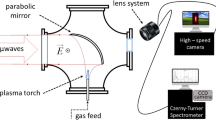Abstract
The technical feasibility of using an induction-coupled plasma (ICP) torch to synthesize ozone at atmospheric pressure is explored. Ozone concentrations up to ~250 ppm were achieved using a thermal plasma reactor system based on an ICP torch operating at 2.5 MHz and ~11 kVA with an argon/oxygen mixture as the plasma-forming gas. The corresponding production rate and yield were ~20 g ozone/hr and ~2g ozone/kWh, respectively. A gaseous oxygen quench formed ozone by rapid mixing of molecular oxygen with atomic oxygen produced by the torch. The ozone concentration in the reaction chamber was measured by Fourier Transform infrared (FTIR) spectroscopy over a wide range of experimental conditions and configurations. The geometry of the quench gas flow, the quench flow velocity, and the quench flow rate played important roles in determining the ozone concentration. The ozone concentration was sensitive to the torch RF power, but was insensitive to the torch gas flow rates. These observations are interpreted within the framework of a simple model of ozone synthesis.
Similar content being viewed by others
REFERENCES
M. Horvath, L. Bilitzky, and J. Hüttner, Ozone, Elsevier, Amsterdam (1985).
B. Eliasson, M. Hirth, and U. Kogelschatz, J. Phys. D20, 1421 (1987).
U. Kogelschatz and B. Eliasson, “Ozone Generation and Applications,” in Handbook of Electrostatic Processes, Marcel Dekker, New York (1995), pp. 581–605.
B. Eliasson and U. Kogelschatz, “Basic Data for Modeling of Electrical Discharges in Gases: Oxygen,” Technical Report KLR 86-11 C, ASEA Brown Boveri (1986).
W. G. Mallard, F. Westley, J. T. Herron, R. F. Hampson, and D. H. Frizzell, NIST Chemical Kinetics Database: Version 6.0, National Institute of Standards and Technology, Gaithersburg, Maryland (1994).
M. I. Boulos, R. Ye, and P. Proulx, University of Sherbrooke, private communication (1997).
M. Rahmane, G. Soucy, and M. I. Boulos, Plasma Chem. Plasma Proc. 16, 169S (1996).
D. R. Bowling, “Mixing in Gas-Phase Turbulent Jets,” in Encyclopedia of Fluid Mechanics, Supplement 2, Gulf Publishing, Houston, Texas (1993), pp. 1–25.
T. B. Reed, J. Appl. Phys. 32, 821 (1961).
M. Tuszewski, “Efficiency of Inductively Coupled Plasmas for Environmental Recycling,” Los Alamos National Laboratory, New Mexico, CRADA Report, February (1994).
M. I. Boulos, “Induction Plasma Processing for Material Synthesis and Waste Treatment,” Proc. Workshop Ind. Applications Plasma Chemistry, 12th Intern. Symp. Plasma Chem. (ISPC-12), IUPAC, Minneapolis, Minneapolis, August 25–26, Vol. B Thermal Plasma Applications (1995), pp. 89–95.
J. Jurewicz and M. I. Boulos, “High Energy Density Induction Plasma System for Materials Processing,” Proc. 5th Natl. Thermal Spray Conf. (NTSC '93), ASM Int'l., Anaheim, Califormia (1993), pp. 89–95.
R. W. Smith et al., “Induction-Coupled Plasma Energy Recycle and Conversion (PERC) of Military Waste Streams,” Proc. Workshop Ind. Applications Plasma Chem. 12th Intern. Symp. Plasma Chem. (ISPC-12), IUPAC, Minneapolis, Minneapolis, August 25–26, Vol. B Thermal Plasma Applications (1995), p. 1057.
P. R. Grittiths and J. A. de Haseth Fourier Transform Infrared Spectrometry, John Wiley and Sons, New York (1986).
T. A. Cleland and D. W. Hess, J. Appl. Phys. 64, 1068 (1988).
M. J. Goeckner et al., J. Vac. Sci. Technol. A12, 3120 (1994).
D. J. McCaa and J. H. Shaw, J. Mol. Spectrosc. 25, 374 (1968).
J. M. Hollas, Modern Spectroscopy, 2nd edn. John Wiley and Sons, New York (1992).
R. Oberly, et al., J. Mol. Spectrosc. 25, 138 (1968).
G. Herzberg, Molecular Spectra and Molecular Structure, Vol. II, Infrared and Raman Spectra of Polyatomic Molecules, Van Nostrand, Princeton, New Jersey (1956).
Author information
Authors and Affiliations
Rights and permissions
About this article
Cite this article
Stratton, B.C., Knight, R., Mikkelsen, D.R. et al. Synthesis of Ozone at Atmospheric Pressure by a Quenched Induction-Coupled Plasma Torch. Plasma Chemistry and Plasma Processing 19, 191–216 (1999). https://doi.org/10.1023/A:1021639608291
Issue Date:
DOI: https://doi.org/10.1023/A:1021639608291




